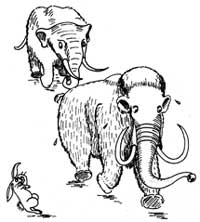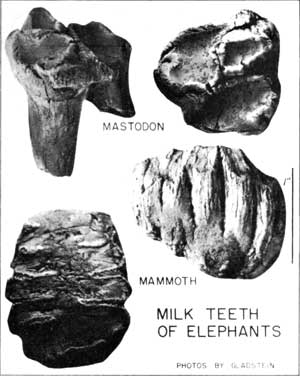
 | ||||||||||
| Intro | Author | Subject | Volume | Volume/Title | NPS | |||||
|
Volume III - No. 3 |
September, 1939 |
|

In the ordinary course of events, the ocean is the great receiver ---- the world's greatest collector. It collects the sediments that are eroded from the land by streams, winds, waves and glaciers. As the earth's most populous burial ground, it receives the shells and bodies of countless organisms that swim in it or drift upon its surface. It also, upon occasion, receives the bodies of animals that lived upon the land. During times of Widespread upheaval many or these things are restored to the land, but only rarely does the ocean itself become an active agent in a process of giving back to the land the bones of animals that once roamed upon it. It is our purpose here to describe such a case. At Edisto Beach State Park in South Carolina the bones and teeth of long-extinct animals --- animals that lived upon the land in the Ice Age --- are being excavated from the ocean floor and washed ashore by storm waves of the modern Atlantic. 
There is, of course, no actual migration as in the
fanciful sketch which appears on this page, but the event nevertheless
has some of the elements of an anachronism. Ancient animals are being
washed ashore by the sea which, contrary to its custom, is acting as the
giver rather than the receiver. If this situation is not anachronistic
it certainly is paradoxical --- a reversal of a normal process of
nature. The cavalcade of animals that comes piecemeal to the shores of
Edisto includes beasts that seem strangely un-American. It includes
elephants --- Woolly Mammoths and Mastodons --- Ground Sloths, Giant
Beavers, Tapirs, Giant Armadillos, Royal Bison. It includes horses that
lived and died here long before the Spaniards brought the first of our
present stock in the early 16th century. But these venerable inhabitants
of South Carolina are not un-American. It is we who are the newcomers!
Before we can arrive at a satisfactory answer to this question we shall have to learn a little more about the existing situation at Edisto Beach. In picturing the ocean at Edisto as a giver we were being overly generous with that relentless foe of the land. Edisto lies in a broad reentrant in the coast line --- an arc, concave landward, that extends 180 miles from Charleston to the Florida boundary. In this arc today at Edisto, the waves are eating into the land at the measured rate of 15 feet a year, and there is clear evidence to indicate that the process has been going on for a long time.
On the present beach at Edisto a bed of green mud outcrops close to low tide level. During his early investigations in the area Mr. Rutledge discovered bones in this layer of mud. Believing the bones to be fossil he carefully excavated them, pleased with the prospect of obtaining a complete skeleton. To his dismay the skeleton proved to be that of a very modern cow! Since the cow could not have become buried in the mud at the present site of outcrop, this strange occurrence indicates that what is now the beach was once marsh land and that the sea has moved inland a considerable distance within historic times. The ocean exacts a stiff price for our collection of old bones! A glance at a Hydrographic Chart gives us additional information of interest. The sea off Edisto is very shallow, the "continental shelf" being about 70 miles wide. All the sea bottom within five miles of shore is less than 40 feet deep. If sea level were to be lowered 150 feet the shore would be extended 55 miles! This point is significant and will be referred to later. From actual observations we know little about the materials that form the sea floor but we do know that the flat strip of country forming the present coast is underlain by marine deposits of the Ice Age. From this strip --- known as the Pamlico Terrace --- marine shells have been collected to levels 12 feet above low tide. This assemblage includes a large number of species that live today only in warmer latitudes.1 We shall show later that this fact is not extraordinary, for the shells lived during an inter-glacial epoch when the sea stood higher and the climate was warmer. 
We do not know the exact thickness of the Ice Age deposits at Edisto Beach but the fossiliferous portion is probably only a few feet thick and probably lies close to sea level. At Coffin Point 10 miles to the southwest, where the Service's core drill put down an exploratory well, we entered sediments at a depth of 72 feet that appeared to be definitely older than the Ice Age. This gives us at least a maximum figure for this general area and one that compares favorably with other drilling records. The deposits of the Ice Age consist of beds of dark mud with some sand and shell. The vertebrate fossils are impregnated with mineral matter and their outer surfaces are stained nearly black by organic material. Some of the larger ones come ashore encrusted with sand and recent marine shells, indicating that they have lain exposed on the sea bottom for some time before being cast upon the beach. Before continuing our description of the process of excavation let us consider the conditions that existed in the world during the Ice Age. In that period tremendous quantities of water were taken out of the oceans and locked up on the land in the form of glacial ice. About one-sixth of all the lands now in existence were blanketed with ice. About one-half of North America was covered. The ice extended from Alaska to Greenland and southward to the Ohio and Missouri Rivers. South Carolina was not glaciated but it felt the effects in a somewhat cooler climate and in the fact that the sea was lowered at least 150 feet, possibly much more. This latter, as previously mentioned, greatly extended the land area to the southeast. From what is now the coast of South Carolina a broad flat extended seaward for more than 50 miles. This area lay close to sea level and parts of it doubtless were swampy traps for unwary animals, as are parts of the Coastal Plain today. We should mention at this point there was not just one epoch of glaciation --- there were four. These cold epochs were separated by warmer inter-glacial epochs. During these times the ice melted, the glaciers retreated northward and sea level came back to normal. In South Carolina during each warm epoch the sea rose to cover the shelf that had been exposed during the preceding glacial stage. Sea animals flourished and shell beds were formed. As the glaciers re-advanced the sea retreated and the land animals that lived along the margin of the glaciers retreated southward ahead of the invading ice. They inhabited parts of the newly exposed land and left their bones to mingle with those of sea animals. These changes took place slowly, of course, and it is estimated that the entire Ice Age (not counting the present epoch, which may be just another inter-glacial stage) occupied a span of 2,000,000 years. The fact that the Edisto deposits that now are being excavated contain the remains of bison and bears --- animals that apparently did not migrate into America until the closing stages of the Ice Age --- suggests that our deposit is fairly young. It is difficult to determine the exact age because the fauna that is being washed up is considerably mixed. The waves may have access to two or more thin deposits of different ages. Some of the sharks' teeth belong to species that antedate the Ice Age but these teeth are resistant objects that may have been reworked --- mixed up with Ice Age deposits during the Ice Age. Likewise, it is known that some of the typical Ice Age mammals that are now extinct -- American horses, the Giant Sloth, Mastodon, and Woolly Mammoth --- persisted in North America until a few thousand years ago. These particular animals were still in existence following the retreat of the last glacier and some, at least, after the arrival of the earliest human beings on this continent. You may ask, is it, then, not possible that the Edisto waves may uncover human artifacts or actual skeletal remains? It is possible but very unlikely. We shall not attempt in this brief account to describe the appearance or the habits of all of South Carolina's numerous extinct animals but Mr. Kiener has sketched some of the commoner ones, basing his sketches on well known restorations. Only bones and teeth and plates are found at Edisto and Irving Gladstein has kindly photographed a number of these. Of particular interest are the tiny milk teeth of the elephants2 --- one from the browzing mastodon, the other from the mammoth, a grazing animal. Bones of the former have been found associated with human artifacts in Florida; frozen bodies of the latter have been recovered in arctic regions. The Giant Sloth that lived in the Edisto region bore little resemblance to his modern tree-dwelling relative. The Ice Age sloth was a ground-dweller that stood erect to pull down branches with its claws. It probably lumbered awkwardly on all-fours, walking on the outer edges of its feet. Some of the horses were as large as those living today. Many believe that the fossils that are being washed up at Edisto are brought to the coast by streams, but to the writer it seems unlikely that such is the case. Nearby streams, such as South Edisto River, are sluggish and carry only fine sediment. It seems doubtful that they could bring down large heavy bones even if aided by tidal currents. Mr. Rutledge, who probably knows the area better than anyone, reported that the largest bone that he found weighed close to 40 pounds. The writer weighed the largest one now in the Edisto Museum --- a fragment of elephant bone --- and found that it weighed 20-1/4 pounds. Mr. Jaworski, who collected 967 specimens, reported that they were most abundant at high tide mark on the Edisto front beach and in the area immediately to the north east. Fossils were comparatively rare on Bay Point and on the beach fronting South Edisto River. Mr. Jaworski also pointed out that bone fragments less than 2/3 inches long were rare. In the writer's opinion, the waves at Edisto are eating into an unusually rich concentration of vertebrate remains buried just below sea level. In this connection it is interesting to note that the nearby Hunting Island beach, which, like Edisto, is receding rapidly landward, has not yielded a single fossil although it has been searched carefully.
(1) H. G. Richards, "Fauna of the Pleistocene Pamlico Formation of the Southern Atlantic Coastal Plain." Geological Society of America Bulletin, vol. 47, pp. 1638, 1640, 1936. (2) My identification of these teeth has been verified by Dr. C. L. Gazin of the United States National Museum. (click to see an original image of first page of this article) | |
| <<< Previous | > Contents < | Next >>> | ||
|
http://www.cr.nps.gov/history/online_books/regional_review/vol3-3b.htm Date: 04-Jul-2002 | ||||